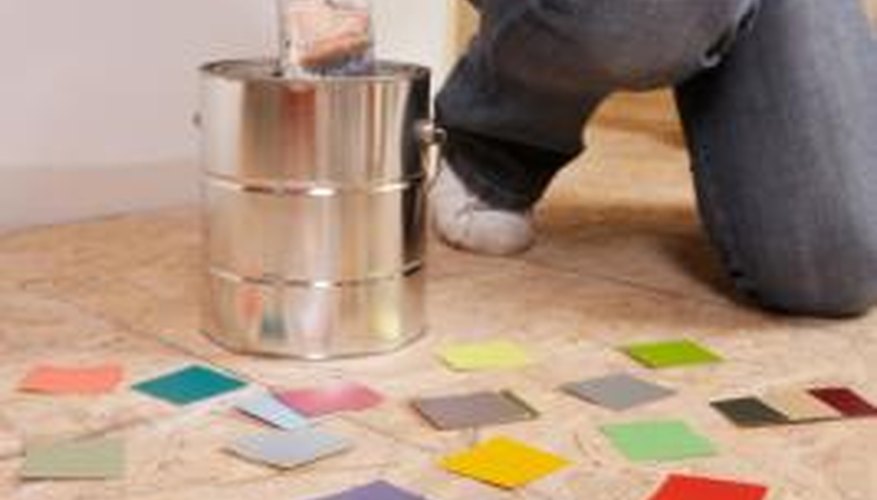An emulsion is a liquid made from at least two materials that don't mix, for example oil and water. Emulsion paint consists of pigment, synthetic particles and water. After application, the water evaporates, leaving the pigment and synthetics, usually acrylic, on the surface. As they dry, these synthetics coalesce, so that subsequent exposure to water does not affect them. Emulsion paint is often called latex paint, although latex rubber is not an ingredient. Emulsion paint is versatile and can be used in many ways.
- An emulsion is a liquid made from at least two materials that don't mix, for example oil and water.
Use emulsion paint on walls, ceilings, brick, plaster, concrete, wood and metal. It also can be used by artists for large projects.
Prepare the surface by ensuring it is clean and free from dust. Remove any previous unstable paint by sanding, either by hand with sand paper or with an electric sander. Always wear a protective mask when removing old paint. Use a damp cloth to remove dust.
Thin emulsion paint 50/50 with water. Use this to seal unpainted surfaces. New plaster will soak up the thinned emulsion, providing a good surface ready for priming. Ensure plaster is dry before painting.
- Prepare the surface by ensuring it is clean and free from dust.
- Use this to seal unpainted surfaces.
Make your own primer by diluting emulsion paint 80/20 with water. Using the same paint for primer and top coat ensures that the finish will be streak free.
Apply emulsion with a brush, roller, rag, sponge or airbrush. It usually takes an average of two hours to dry, depending upon the viscosity of the paint. When painting walls, always work toward the source of light.
Dilute emulsion paint with about 10 per cent water, and use to create paint effects, such as sponging, stippling, dragging, graining, stencilling and rag-rolling.
- Make your own primer by diluting emulsion paint 80/20 with water.
- Dilute emulsion paint with about 10 per cent water, and use to create paint effects, such as sponging, stippling, dragging, graining, stencilling and rag-rolling.
Experiment by painting emulsion over a coat of different coloured oil-based paint, that has been allowed to dry until tacky. You can get an interesting crackle-graze effect, with the base colour showing through the cracks in the emulsion.
Disguise central heating radiators by painting them with the same paint as used on the walls. Protect with a coat of flat water-based varnish. This does not effect heat output.
TIP
The shinier the finish, the more hard-wearing the paint. There are generally three types of finish available in commercial emulsion: flat or matt, satin and silk. Clean brushes with water. Seal an emulsion-painted surface with water-based varnish if it needs to withstand wear and tear. If you get emulsion on your clothes, wash them immediately and the paint should come out easily. Make your own emulsion paint from milk, builder's lime, pigment and chalk. The fat and water in the milk provide the emulsion.
WARNING
Emulsion is difficult to remove from wood, and will have to be sanded off. Chemical paint remover will not work on water-based paint.
